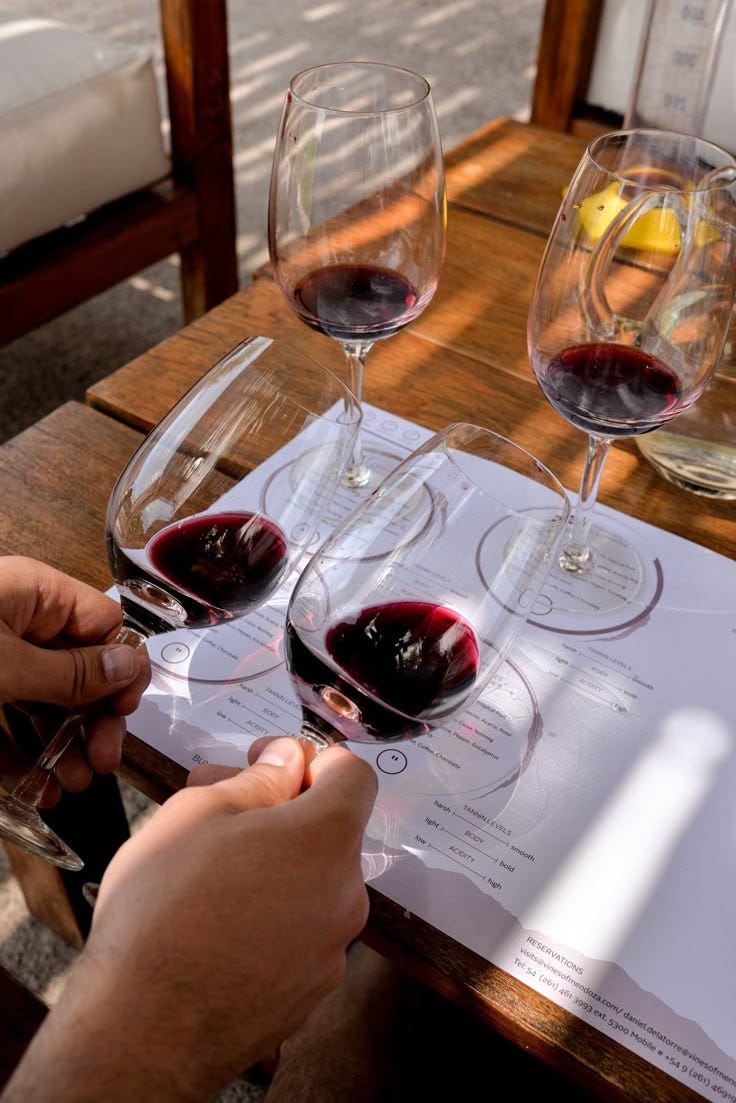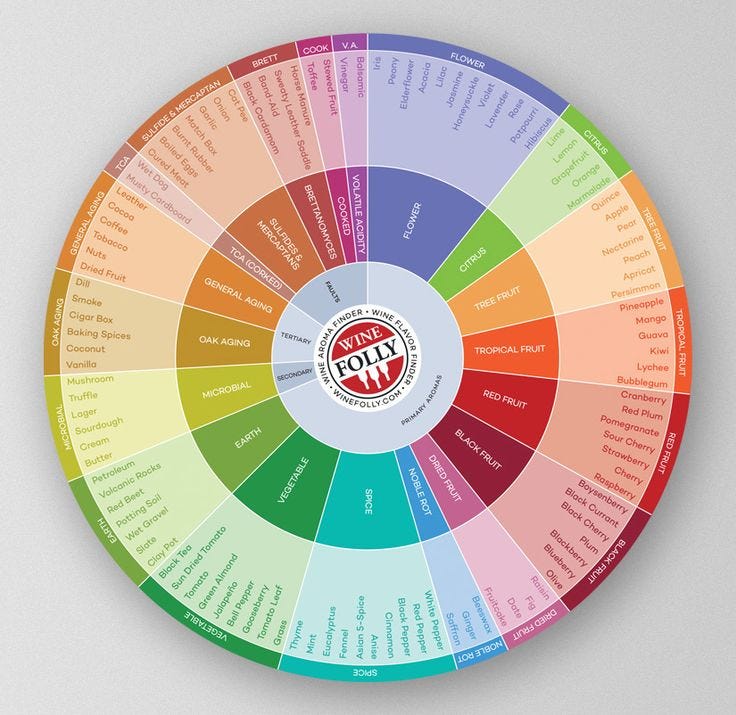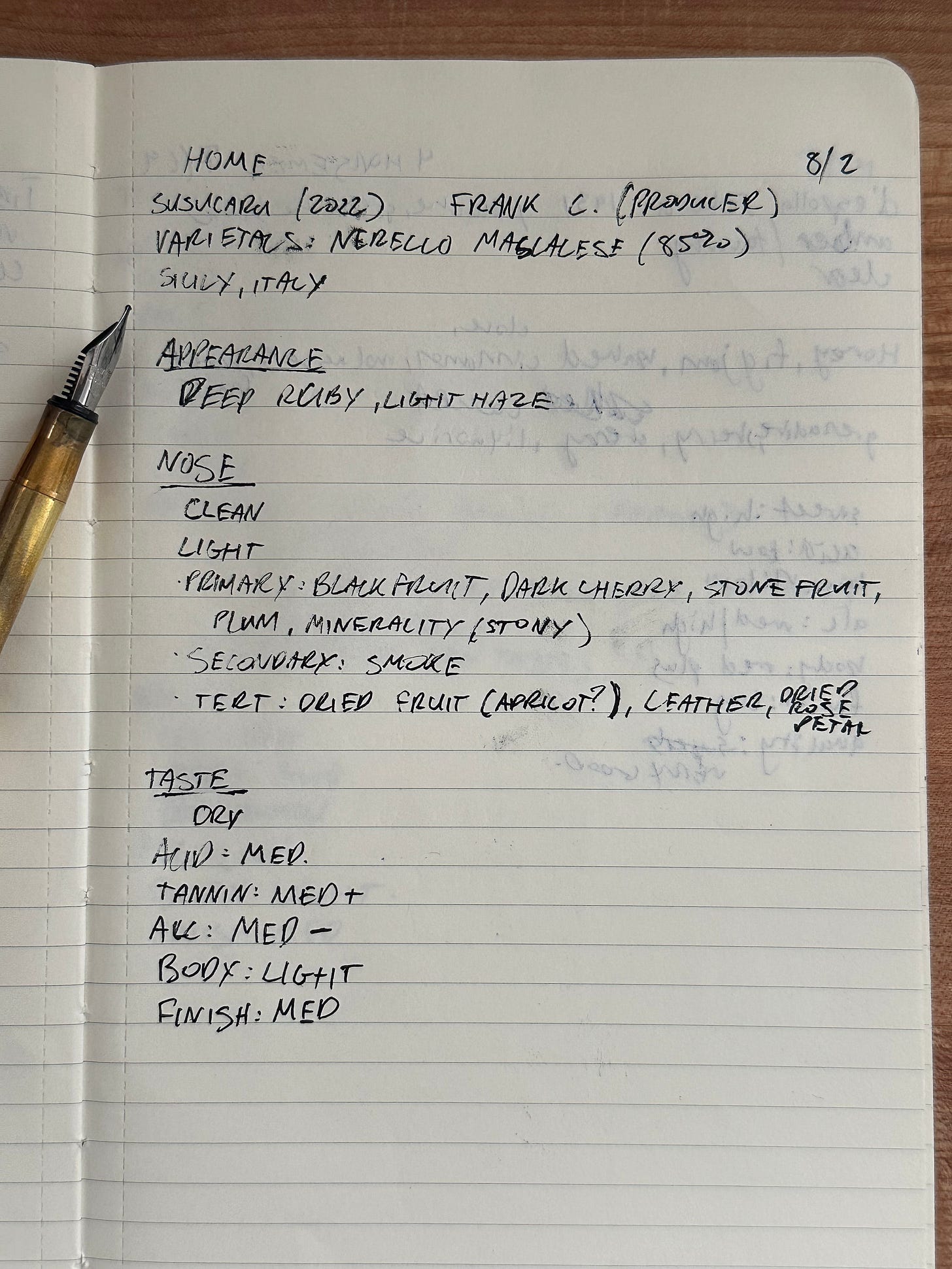The basics of tasting wine
"This wine tastes like grape juice." Well, you might not be wrong. A guide to talking about wine confidently.
Before we dive right in, this post is a part of my basics of learning about wine series, scroll all the way to the bottom to see the full list such as “How to order at a wine bar”, “Wine Glossary”, “Wine Starter Pack” and more.
Everyone has that friend who makes the same “it tastes like grape juice” joke when drinking wine. (Honestly though, sometimes there’s no better descriptor). It’s hard to discuss something subjective and opinionated like taste: whether in food, wine, music, movies, whatever. No one wants to be ‘wrong’ or feel embarrassed about they like.
But, what if I told you, you can take (most of) the subjectivity out of tasting wine?
There’s a way to critique wine so that you don’t feel paralysis when someone asks you, “So what did you think of the wine?” For me, my mind used to go blank. Once I learned the steps of how to properly taste, I now have a mental cheat sheet I can refer to instead of struggling at what should be an easy question.
A caveat emptor for the reader: there’s no right way to drink wine other than for enjoyment—like any sensory experience. For some (like me) it can be helpful and fun to think about it a step deeper. By really understanding what you’re drinking, the easier it becomes to find other wines you’ll like. Like creating your own personal algorithm.
For instance, if you know you like an artist like Khruangbin, which I would classify as indie funky psychedelic—instead of listening to only their music, you could search by genre to find other artists with a similar style to what you already like. (an example, in wine terms: jammy, light bodied, spiced, chilled reds).
With that in mind…here’s a 3-step guide to assess wine that still includes the most fun part, which is just plain drinking and enjoying.
Still with me?
Okay, grab some wine, a wine glass, a white sheet of paper, and a pencil (or your phone) and let’s get started.
Learning the SATs
Comically, this tasting method is called the SAT (Systematic Approach to Tasting Wine), which is something you learn about when taking the WSET. This will be your framework to taste wine objectively. (Leave it up to an Asian business-grad to get excited about learning a framework to drink wine). It’s short and simple, I promise.
3 Step Method
Step 1: Appearance (Looking)
Pour your wine into a glass. Look at the wine over a white sheet of paper (or something close). This is where we tilt the glass at an angle and look at it inquisitively.
Clarity
Look at the clarity (are there any fuzzies or sediment in there?). No fuzzies = clear. Clarity is not a good or bad thing, more haziness will likely mean the wine tastes rounder or creamier (due to lees aging).
Intensity
Check out the color, how deep or intense is it? Tilt the glass at an angle just before any liquid would drip out—if the wine is colorless at the rim, it’s pale. If you can barely see through it, it’s deep.
Color
Is it a white, rosé, orange (use white & rosé colors to assess orange wine), or red? Use the guide above to gauge color. ‘Purple’ typically has hues of blue. Color is a literal spectrum, so think of this as a fun color theory game rather than being definitive.
Jot all of these answers down on a sheet, your phone, or your head and repeat for each step below.
Step 2: Nose (Smelling)
Alright, no more looking—now we begin smelling the wine. Swirl the glass and then stick your nose into the glass of wine. Get really in there and get a good whiff. 2-3 sniffs is perfect for this section.
Condition
This is the point in which if you got served a bad wine, you would send it back in a restaurant (est. 1 in 75 wines are faulty). If it smells too vinegary, horsey/farmyard, like a band-aid, mousey, then it may have gone bad and you should ask for another. If unsure, ask the server/somm to smell! Sometimes, these aromas can be intentional, others, maybe not.
Intensity
If you’re struggling to pick up any initial aromas (fruits, flowers, herbs) after you swirl and sniff inside the glass, then it may be considered “light”. If you can smell the wine’s aromas from outside of your glass, then it’s probably “pronounced”.
Aroma characteristics
There’s 3 types of aromas—primary, secondary, and tertiary (I explain each one below). An aroma wheel can come in handy if your mind is hitting a blank. Not all wines have all 3 types of aromas. If you can’t smell it, it may not be there. Try your best to pick out at least 2 aromas (fruits, flowers, etc.) before tasting.
Primary Aromas (aromas from the grape / fermentation) are the fruit, flower, and herb aromas.
Secondary aromas (post-fermentation, oak-aging, yeast aging) are the bread-y, smoke, cream, vanilla, and buttery aromas.
Tertiary aromas (from aging and oxidation) are the leather, dried fruits, honey, and mushroom aromas.
Step 3: Palate (Tasting)
We made it! Aromas (during the Nose step) are more easily picked up by smelling, so the tasting portion is more focused on sensations like sweetness, acid, tannin, alcohol, body (but you can add more flavor notes after tasting too).
Alright, let’s drink! Take a good glug, swish it around your mouth to release the flavors and fully taste the wine.
Sweetness
We are generally good at tasting sweetness. Most wines will be ‘dry’, which means they have less than 4g/L of residual sugar in them. If it tastes like it has more than a hint of sweetness, it’s likely off-dry (aka halbtrocken, semi-dry), and the list goes on. Usually producers will label its sweetness if its not dry. Especially common to label sweetness on sparkling wines (Cava, Prosecco, Champagne, Crémant).
Acid
Acid is that mouthwatering sensation in your mouth. It makes wine bright and fresh (think squeezing lemon over grilled fish). Higher acid, higher salivation.
Tannin
These come from the grape skins, seeds, stem, and (if used) oak. The opposite effect of acid but easily confused with it, this is the mouth drying and bitter sensation. You should feel this on your gums & tongue. Leaner white wines (like Sauv Blanc) generally don’t have tannins (while orange wines do since they are fermented with skins), while a big bold red wine (like Cab Sauv) will likely have a lot.
Alcohol
Have you ever taken a shot of liquor? Notice how it literally makes you feel warm and your cheeks feel flushed? This is why when a wine has high alcohol, its called ‘hot’. White wines are typically lower in alcohol and red wines typically higher. Alcohol percentage gets easier to gauge with wine experience and soon you’ll begin predicting alcohol % with good enough accuracy within 0.5% range.
Body
Light, medium, full body is like comparing skim vs whole milk in your mouth—there’s almost a literal weightiness and different mouthfeel when drinking the two. Comparatively, a dry white wine like a Riesling is light and dainty, while a Syrah will feel much fuller.
Finish
This is the aftertaste of wine. The longer the aftertaste is retained in your mouth, the longer the finish. There’s no defined times for short, medium, or long—it’s arbitrary. Short would be roughly less than 5 seconds, medium 5+, long is 30+ seconds.
You did it! The full 3-step tasting: appearance, nose, and palate.
Now is the time to think about the overall experience. How did you feel about it? How was the quality? Poor, acceptable, good, great, or fantastic?
Some questions to help you decide on the quality: Was it balanced? (Not too sweet, not too harshly acidic)? Good for the value? (Tasty, didn’t break the bank, fits the occasion). Interesting/Unique?
For me, it’s easier to break down a wine in structured terms so it removes some levels of subjectivity. We don’t have to like everything, even if someone tells you it’s good. You may not like something, but this guide helps to determine if it objectively can be considered higher quality. Like a work shown at the MoMA or MET, whether its renaissance paintings or avant garde art—it may not be for you, but you can understand it has its place and it took a masterful level of care to create.
Cheers! Happy swirling 🍷
Appreciate you for reading, your support is what’s keeping this newsletter alive. Please share with a friend, leave a comment, and subscribe. Say hello on Instagram ☺︎.
If you’re interested in partnering up for a future event or collaboration—send me an email at ericdo95@gmail.com.
Wine Basics
















agreed! there was a natural wine fair in France where they famously said to producers not to bring their stupid undrinkable wines for the sake of being "natural"
Bookmarking this so I can check back next time I’m drinking wine